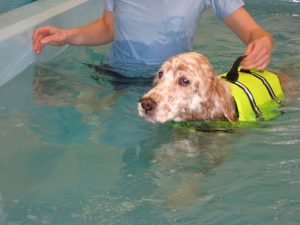VETERINARY PHYSICAL REHABILITATION
 What is physical rehabilitation therapy?
What is physical rehabilitation therapy?
Veterinary physical rehabilitation therapy, similar to what is known in the human field as physical therapy or physiotherapy, involves the use of specific non-invasive treatments (massage, exercise, light, heat, cold, electricity, ultrasound, laser, magnetic therapy, hydrotherapy, etc.) to rehabilitate injured patients. The goal of physical rehabilitation is to return the patient to normal function as quickly as possible, and to restore the full range of movement and strength to injured body parts. The underlying principle of physical rehabilitation is that the least effective treatment for injury is excessive rest, and that stimulation of circulation through areas recovering from injury promotes an optimal rate and degree of healing.
What is the history of rehabilitation therapy in veterinary medicine?
Although various forms of physical therapy have undoubtedly been used for centuries on animals, the foundation for its use as an applied science is very recent. TheAmericanAssociation of Equine Practitioners established a set of guidelines for the practice of physical therapy on horses in 1993.The AVMA and the American Physical Therapy Association are currently working on establishing guidelines for the practice of veterinary physical therapy and coursework on animal rehabilitation therapy has become increasingly available through veterinary colleges and other veterinary affiliated organizations.
On which species of animals is physical rehabilitation practiced regularly?
Physiotherapy is practiced regularly on horses, especially equine athletes. As a form of treatment, it is beginning to be used in dogs and is becoming increasingly recognized. It could potentially be applied to other animal species as well.
Who practices veterinary rehabilitation and do I need a referral?
Veterinary physical rehabilitation therapy should be performed by a licensed veterinarian. A licensed physical therapist educated in animal’ anatomy and physiology can only treat animals under the direct supervision of a veterinarian, following a veterinary diagnosis and in accordance with state or provincial veterinary regulations.
If a veterinarian is performing the treatments, referral mayor may not be necessary. If a non-veterinarian will be the therapist, the patient must be referred by a veterinarian and the therapist must be under the direct supervision of a veterinarian, who will then assume responsibility for assessing and coordinating the patient’s care.
What conditions are most often treated with physical rehabilitation therapy?
Acute and chronic injuries are amenable to treatment. Electrical stimulation has been shown to relieve pain, minimize muscle atrophy (degeneration) secondary to disuse due to pain or immobilization, reduce tissue swelling, and speed healing of both open and closed wounds. Therapeutic ultrasound or cold laser therapy can be used to stimulate tissue repair and minimize the formation of scar tissue and adhesions. External application of ice and compression wraps is effective not only as a first aid treatment but also to break the pain-muscle spasm-pain cycle common to many musculoskeletal injuries.
How can my pet benefit from rehabilitation therapy?
The appropriate application of physiotherapy will speed healing, relieve pain, and improve the patient’s likelihood of a full recovery.
How successful is rehabilitation therapy?
As a technique to reduce pain and speed healing, the various forms of physical rehabilitation therapy can be very effective.
How safe is physical rehabilitation therapy?
Physical rehabilitation therapy can be performed safely but has the potential for doing significant harm in the hands of individuals with inappropriate education and training.
What is the cost of rehabilitation therapy?
Comprehensive physical therapy requires an initial veterinary assessment and formulation of a treatment plan, which usually consists of a series of treatments. The cost of treatment will reflect both the equipment being used and the skill and experience of the practitioner and therapist. An estimate for your pet’s treatment plan can be provided at the time of initial consult.
Can physical rehabilitation be combined with traditional veterinary medicine?
Rehabilitation therapy is most appropriately used in combination with either traditional or alternative forms of veterinary medicine. A licensed veterinarian should formulate the overall treatment plan, following the appropriate diagnostic examination and assessment of the patient. Follow-up evaluations are necessary to determine the individual’s response to treatment and adjust the therapy accordingly. If your animal companion is receiving physical rehabilitation therapy or any other alternative services from an individual other than your regular veterinarian, that person must report directly to your veterinarian in order to provide coordinated care of your companion, to allow proper evaluation of treatment and to minimize any avoidable interactions or interferences.
How can I find out more information about veterinary rehabilitation therapy?
Your veterinarian should be able to assist you in evaluating the suitability of specific therapy for your companion animal. Our specialists here at Animal Specialty Group work closely with our rehabilitation service. We recommend an appointment be scheduled with Dr. Joanne Bak for further consultation regarding physical rehabilitation.



